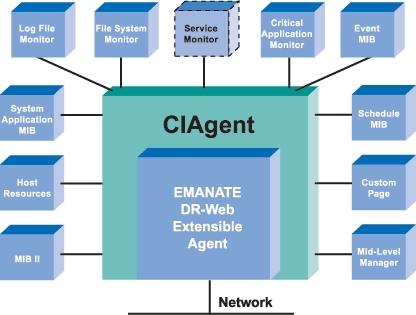CIAgent

CIAgent is a product of SNMP Research, a company that specializes in solutions
for Internet and network security applications.
CIAgent is a secure SNMP agent, combined with the ease of Web-based management.
This standards-based agent is comprised of the EMANATE Master Agent,
multiple extensions for system and application management, and a powerful
(optional) subagent development kit for building custom extensions.

(c) SNMP Research International, Inc
This intelligent agent supports SNMPv1, SNMPv2 and SNMPv3.
CIAgent can be used in the following ways:
- Monitor important applications.
The Critical Application Monitor can be configured to carry out suitable actions
when the application terminates, such as sending a trap or restarting an application.
- Monitor system and application logs.
The Log File Monitor examines log files and performs actions when user
defined patterns are encountered or when the log file exceeds a certain size.
- Monitor available capacity of file systems.
The File System Monitor shows current file systems and sends notification
when the file system reaches near capacity.
In addition, it adds the ability to perform actions based on file system
problems. Other functions include execution of programs or
scripts and/or sending traps.
- Monitor network services.
The Service Monitoring Subagent (optional) is designed to determine if
a service, such as a Web server, FTP server, or SMTP is working properly
and whether response time is within acceptable parameters.
- Manage information via Web browsers.
The DR-Web Extensible Agent enhances the EMANATE Master Agent, providing
EMANATE with an HTTP interface. This allows Web access to the management
information of CIAgent.
- Collect network statistics.
The MIB II (RFC1213, part of STD17), a core component of SNMP agents,
provides almost 200 objects of information about the performance and
statistics of the TCP/IP stack.
- Monitor which applications are currently running.
The System Application MIB (RFC2287) supports configuration,
fault detection, performance monitoring, and control of application
software. This agent creates tables that define an application as a
series of processes and services. This includes tables that show applications
installed on the system, elements and processes that are included in an
application, and current and previously run applications.
- Monitor resources on a system.
The Host Resources MIB (RFC2790, formerly 1514) provides useful information
about the systems and applications running on those systems.
There are approximately 85 different objects available, including the following:
- System
- Type of CPU(s)
- Number of CPUs
- Processor speeds
- System uptime
- Time and date functions
- Processor load
- Storage & File System
- Number and type of disk
- Disk utilization
- System swap configuration
- System memory
- System memory utilization
- Software
- Software installed on the system
- Software running on the system
Reduce the load on centralized managers.
The Mid-Level Manager (MLM) [DisMan] reduces network traffic by
shifting the continual management of a machine from the enterprise
manager to the local machine.
The MLM uses scripts to aggregate, summarize, and transform
data into useful information. This information is then reported
to the enterprise manager. The MLM can be used in conjunction
with any of the included MIBs to monitor objects, based
on time intervals.
Reduce the polling load on centralized managers.
The Event MIB [DisMan] monitors MIB objects and performs actions
that are based on given conditions, such as exceeding a threshold.
Event MIB allows the user to configure traps that are either
standard or enterprise specific. This product is based on the
alarm and event tables from the RMON MIB.
Schedule activities.
The Schedule MIB [DisMan] provides scheduling of actions either
periodically or at specified dates and times.
Build in a transition plan.
The Native Agent/Subagent Adapters allow for the smooth coexistence
of CIAgent and the native SNMP agent, which is provided by the underlying
operating system.
Troubleshoot.
The Trapsend utility allows traps to be sent from the command-line
or from shell scripts. Trapsend supports SNMPv1, SNMPv2, and SNMPv3.
Build custom extensions.
The Subagent Development Kit (optional) makes it easy to add custom
subagents that support new MIB modules.

